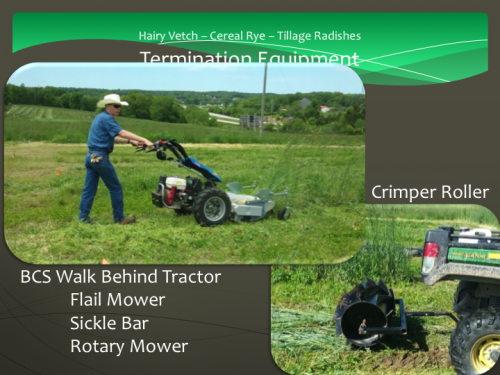Cover Crop Experiments
Cover crop based no-till systems can offer solutions to critical management concerns of organic producers. The adoption of these systems by small and mid-sized producers is limited by a lack of scale-appropriate equipment and strategies. In this project, we seek to develop effective cover crop based no-till systems that could be easily implemented by small producers. Cover crops increase crop yields, slow erosion, improve soil health, enhance water availability, smother weeds, help control pests and diseases and increase biodiversity. In this project, four different cover crop based no-till systems are being tested, and information on soil health, weed density, arthropod diversity, weed seed disease incidence, and summer squash and beet crop yields is being gathered.
1. Hairy Vetch-Rye-Tillage Radish
As a winter hardy cover crop, hairy vetch provides a wide array of ecosystem services including adding organic matter, erosion reduction, weed suppression and nitrogen fixation. Once hairy vetch is established, little management is required. Cereal rye scavenges excess nitrogen, prevents erosion, adds organic matter and suppresses weeds. In the mixture with hairy vetch, rye helps protect the less hardy vetch seedlings through the winter. Tillage radishes control erosion, suppress weeds, scavenge soil nitrate and have a large taproot. In the treatment plots, hairy vetch and cereal rye will be planted in the fall with a push seeder down the length of each bed seeded in alternating rows on 5” centers. The middle 12” of the bed will be reserved for two rows of tillage radishes at approximately 4” in row spacing, which is where squash will be planted in the spring.


We will evaluate five different spring termination methods for the hairy vetch/rye mix in addition to several control methods:
- Roller crimping at rye-vetch bloom
- Occultation (rolling out black plastic tarps and removing them after the cover crop dies)
- Flail mowing
- Sickle bar mowing
- Rotary mowing
- Black plastic on tilled soil after the cover crop
- Tilled soil after termination of cover crop
- Black plastic mulch on tilled soil with no cover crop (control 1)
- Bare tilled soil with no cover crop (control 2)
Summer squash will be planted after termination.

2. White Clover Living Mulch and Tillage Radish
White clover is a good choice for "living mulch" systems because it is a persistent, widely adapted perennial nitrogen producer plant with tough stems and a dense, shallow root mass that protects soil from erosion and suppresses weeds. The optimal temperature for the growth of white clover is 20-25 degrees Celsius, but it is as winter hardy as alfalfa and can withstand frost. Living mulch can be strip tilled at a narrow width to facilitate transplanting with the living mulch. Pairing living mulches with frost-killed tillage radish may offer an alternative to strip tillage.
The following treatments will be compared, and each treatment will be replicated four times following a randomized block design. Summer squash will be planted after termination.
- White Clover with frost killed tillage radish
- White clover alone with strip tillage
- Black plastic mulch on tilled soil after cover crop
- Tilled cover crop
- Black plastic mulch on tilled soil with no cover crop (control 1)
- Bare tilled soil with no cover crop (control 2).

Sorghum-Sudangrass and Cowpeas
Sorghum-sudangrass is an excellent biomass producer. It also smothers weeds, suppresses some nematode species and penetrates compacted subsoil. To reduce nitrogen tie-up from the woody residue, cowpeas (a legume) are interplanted with the grass. Cowpeas suppress weeds, are a nitrogen source, build soil and prevent erosion. We are testing whether varying amounts of compost placed at planting hole sites in the fall after the cover crop is killed by frost will facilitate residue degradation and ease of summer squash transplant placement in the spring.

Tillage Radish
Tillage radish produces a large taproot and penetrates compacted soil sayers to increase soil aeration and water infiltration, reduce compaction and increase rooting depth for successive crops. Using tillage radishes as a cover crop can control erosion, build soil, and suppress weeds. They have been shown to be good scavengers of residual soil nitrate and their performance is highly influenced by planting date. The minimum soil temperatures for tillage radish germination is 45 degrees F, so they can be planted late in the fall and still germinate. The goal of this trial is to evaluate frost-killed radish for use in a direct seeded system for spring production of beets.

Funding

This project was funded by the Organic Research and Extension Initiative (OREI), part of the USDA National Institute of Food and Agriculture, Grant Number 2017-51300-26810.
